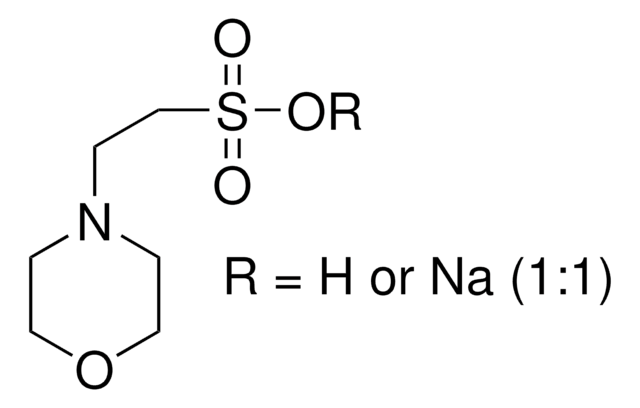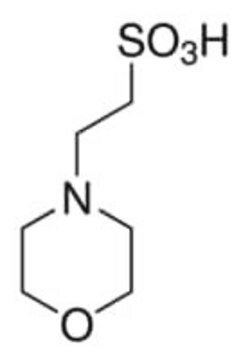M5057
MES sodium salt
BioReagent, ≥99% (titration), crystalline
Sinónimos:
Ácido 2-(N-morfolino)etanosulfónico sodium salt, Ácido 4-morfolinoetanosulfónico sodium salt
About This Item
Productos recomendados
Línea del producto
BioReagent
Nivel de calidad
Ensayo
≥99% (titration)
Formulario
crystalline
pH
8.9-10.1 (1% in water)
intervalo de pH útil
5.5-6.7
pKa
6.1
solubilidad
water: 0.5 g/mL, clear, colorless
aplicaciones
diagnostic assay manufacturing
temp. de almacenamiento
room temp
cadena SMILES
[Na+].[O-]S(=O)(=O)CCN1CCOCC1
InChI
1S/C6H13NO4S.Na/c8-12(9,10)6-3-7-1-4-11-5-2-7;/h1-6H2,(H,8,9,10);/q;+1/p-1
Clave InChI
IRHWMYKYLWNHTL-UHFFFAOYSA-M
¿Está buscando productos similares? Visita Guía de comparación de productos
Categorías relacionadas
Descripción general
Aplicación
- To achieve the required density and stretching of DNA fibers during melting of agarose plugs containing genomic DNA
- To equilibrate the Balch homogenizer chamber and to prevent sample hydrolysis before sample homogenization
Nota de preparación
Otras notas
¿No encuentra el producto adecuado?
Pruebe nuestro Herramienta de selección de productos.
Código de clase de almacenamiento
13 - Non Combustible Solids
Clase de riesgo para el agua (WGK)
WGK 1
Punto de inflamabilidad (°F)
Not applicable
Punto de inflamabilidad (°C)
Not applicable
Equipo de protección personal
Eyeshields, Gloves, type N95 (US)
Elija entre una de las versiones más recientes:
¿Ya tiene este producto?
Encuentre la documentación para los productos que ha comprado recientemente en la Biblioteca de documentos.
Los clientes también vieron
Nuestro equipo de científicos tiene experiencia en todas las áreas de investigación: Ciencias de la vida, Ciencia de los materiales, Síntesis química, Cromatografía, Analítica y muchas otras.
Póngase en contacto con el Servicio técnico







